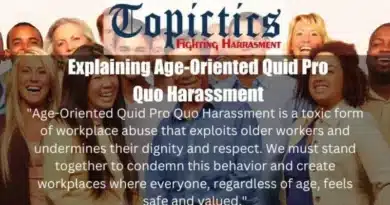What is a Workplace No Quid Pro Quo Harassment Policy?
Here are the key takeaways:
- A “Workplace No Quid Pro Quo Harassment Policy” prohibits exchanges where employment decisions are tied to personal favors or relationships, especially involving sexual advances.
- In a workplace context, quid pro quo harassment occurs when someone in a position of authority attempts to condition promotions, job benefits, or continued employment on an employee’s compliance with inappropriate demands.
- This type of policy aims to protect employees from any such coercive behavior, creating a fair and equitable environment where job-related decisions are based solely on merit and performance, not personal relationships or favors.
Introduction
A Workplace No Quid Pro Quo Harassment Policy is a formal policy adopted by organizations to explicitly prohibit the practice of quid pro quo harassment, which involves an exchange of favors, typically sexual, in return for workplace benefits or to avoid negative consequences.
The term “quid pro quo” means “this for that” and refers to a situation where an employee is asked or expected to provide something, such as a personal or sexual favor, in exchange for professional advancement or retention. This form of harassment most often occurs when a person in a position of authority—such as a supervisor—attempts to leverage their power over subordinates.

Importance of a Workplace No Quid Pro Quo Harassment Policy
Implementing a No Quid Pro Quo Harassment Policy serves multiple purposes for a company:
- Protection of Employees: It ensures that all employees, regardless of their position, are protected from coercive demands by supervisors or others in power. It sets clear boundaries that employees cannot be asked to engage in unethical exchanges to gain promotions, raises, or favorable treatment.
- Compliance with Legal Standards: Quid pro quo harassment is illegal under U.S. law, specifically under Title VII of the Civil Rights Act of 1964, which prohibits discrimination based on sex in the workplace. A clear policy helps organizations comply with these legal standards and avoid costly lawsuits.
- Prevention of Retaliation: A No Quid Pro Quo Policy not only prohibits demands for sexual favors but also protects employees from retaliation if they refuse such demands. Retaliation can take many forms, including demotion, isolation, or wrongful termination, all of which are addressed under the policy.
Key Elements of a Workplace No Quid Pro Quo Policy
- Zero Tolerance for Quid Pro Quo Harassment: The policy must clearly state that quid pro quo harassment is unacceptable, and all employees, regardless of rank, will be held accountable.
- Comprehensive Reporting Mechanism: Employees need to have access to a confidential and effective process for reporting violations. This usually involves multiple avenues, such as HR, a dedicated hotline, or an external ombudsman, so that employees feel safe and empowered to report issues without fear of retaliation.
- Training and Awareness Programs: The policy should include ongoing training for all employees, especially supervisors, to ensure they understand what constitutes quid pro quo harassment and the consequences of engaging in or tolerating such behavior.
- Enforcement and Disciplinary Measures: Any breach of the policy should result in immediate investigation and, if confirmed, appropriate disciplinary actions such as termination or legal proceedings. This ensures that the policy is not just symbolic but actively enforced.
- Protection Against Retaliation: The policy should also emphasize that any form of retaliation against individuals who report quid pro quo harassment will not be tolerated. This provides additional layers of protection for victims and encourages reporting of misconduct.

The Legal Context of No Quid Pro Quo Policies
Quid pro quo harassment is a well-documented legal issue that has led to high-profile lawsuits across many industries. When an employer fails to address a reported case of quid pro quo harassment, it can lead to serious legal consequences, including lawsuits and financial penalties.
Employees who experience such harassment can file claims with the Equal Employment Opportunity Commission (EEOC), which will investigate the complaint and determine whether legal action should be taken.
For employees, the legal protections are clear: quid pro quo harassment is illegal, and employers have an obligation to take action to prevent it. Employees should document all interactions that involve quid pro quo demands, report them to HR, and consult legal advice if necessary.
Many organizations have already faced costly litigation for failing to address quid pro quo issues appropriately, highlighting the importance of having a robust, enforceable No Quid Pro Quo Policy in place.
Examples of Quid Pro Quo Harassment
A classic example of quid pro quo harassment is when a supervisor suggests that an employee can secure a promotion or bonus only if they agree to engage in a personal or sexual relationship with the supervisor.
If the employee refuses, they may face adverse consequences, such as a poor performance review, demotion, or even termination. In such cases, the employee can seek legal recourse because this behavior violates employment laws and constitutes sexual harassment.
Even subtle forms of quid pro quo harassment—such as implying that an employee will lose out on opportunities if they don’t comply with a supervisor’s personal requests—are illegal and should be reported and addressed.
Preventing Quid Pro Quo Harassment in the Workplace
Preventing quid pro quo harassment requires a multi-faceted approach. First, training and education are key. All employees, but especially managers, should undergo regular training to recognize and prevent quid pro quo harassment. They need to understand that even seemingly minor infractions can lead to serious legal and professional consequences.
Second, organizations must foster an environment where reporting misconduct is encouraged and protected. This involves not only having a No Quid Pro Quo Policy but also ensuring that reporting mechanisms are accessible and that employees who report misconduct are safeguarded against retaliation.
Finally, organizations should commit to investigating all reports of harassment swiftly and thoroughly. Failure to investigate or act on reports can not only harm the victim but also expose the organization to legal liability.
Conclusion
A Workplace No Quid Pro Quo Policy is essential for any organization that seeks to create a safe, equitable, and legally compliant environment. By setting clear boundaries against unethical exchanges and ensuring that employees are protected from harassment and retaliation, a well-crafted policy helps build a culture of respect and integrity.
Moreover, it protects the organization from legal repercussions and fosters trust among employees, promoting a healthier and more productive workplace.
For employees, understanding the policy and knowing their rights are crucial steps in safeguarding their professional and personal well-being in the workplace.









